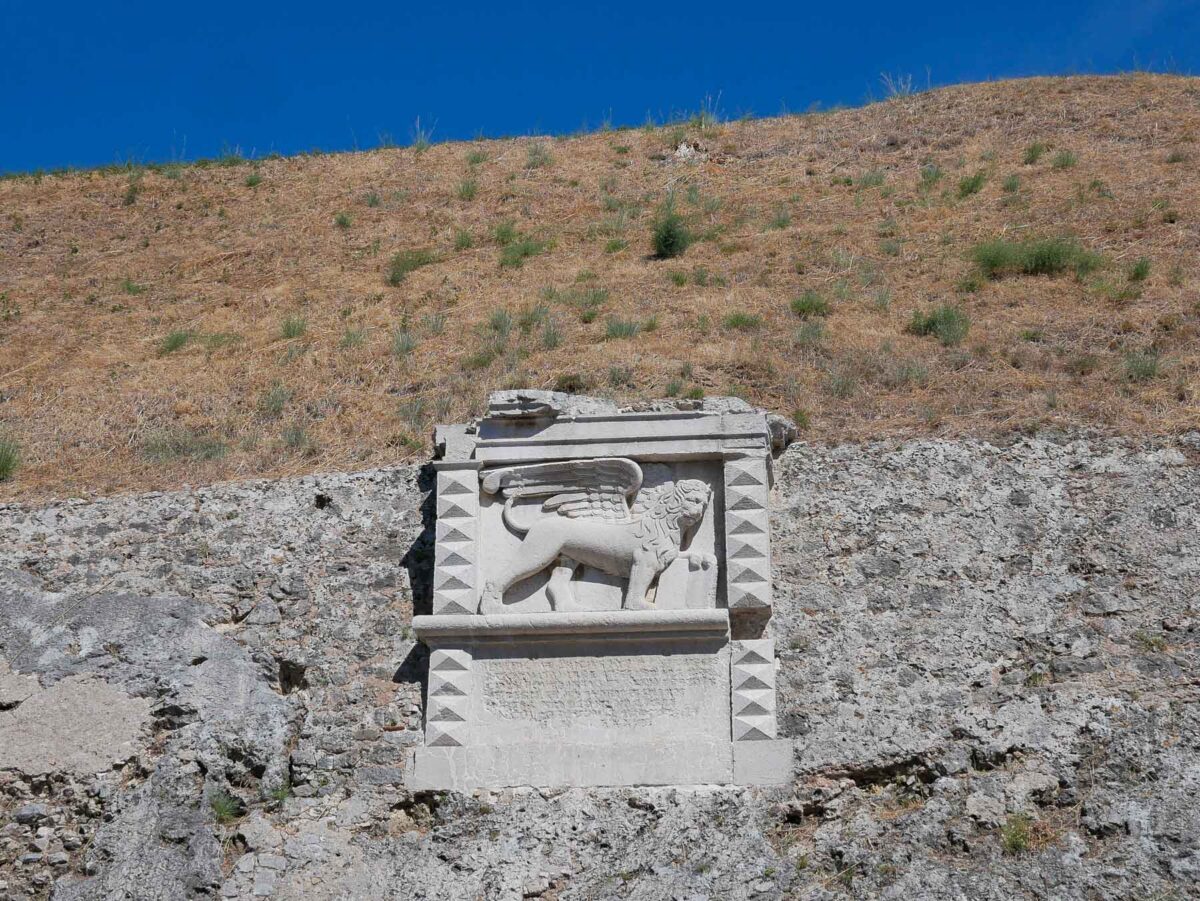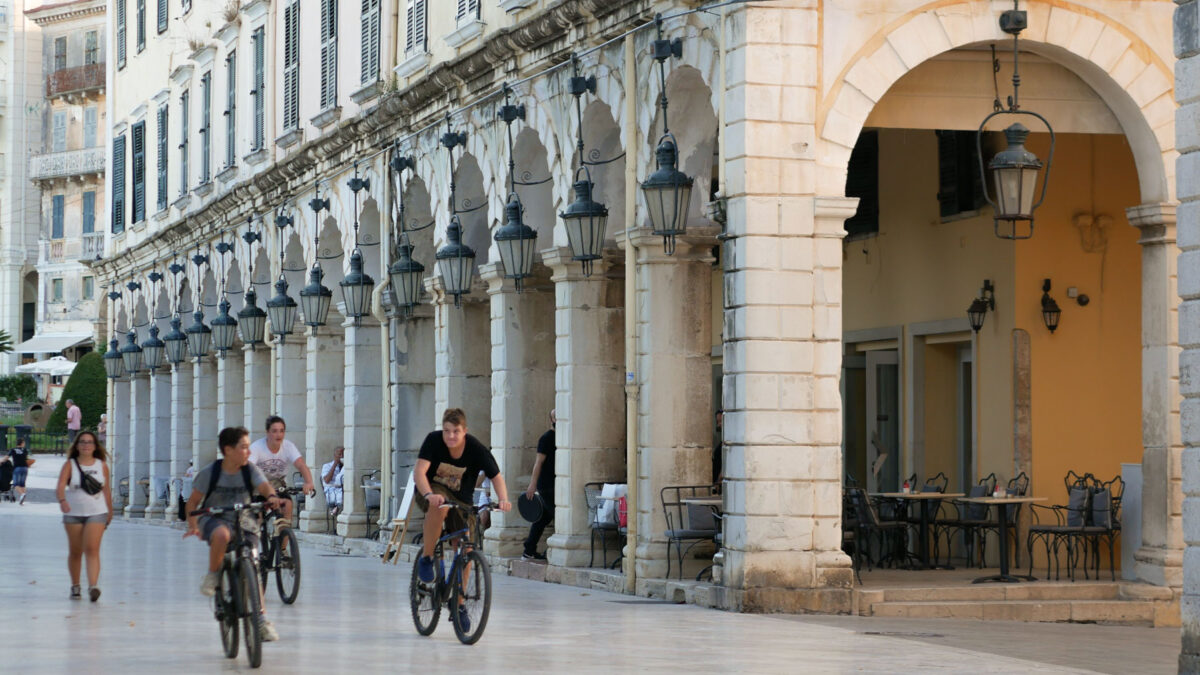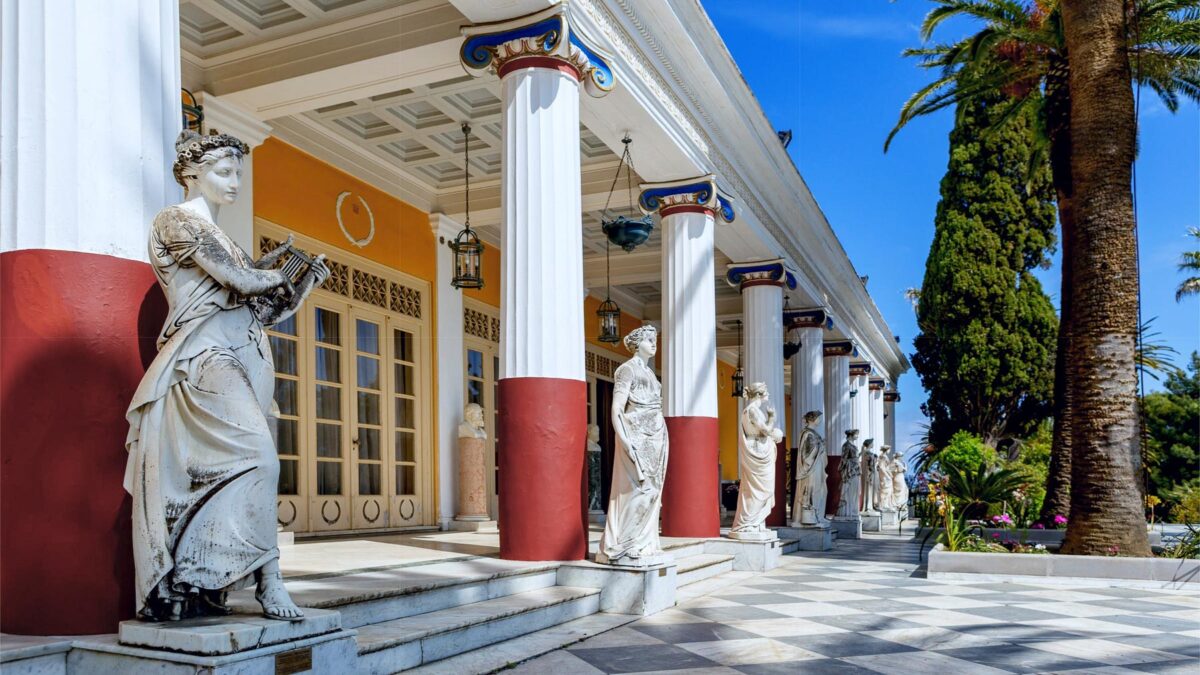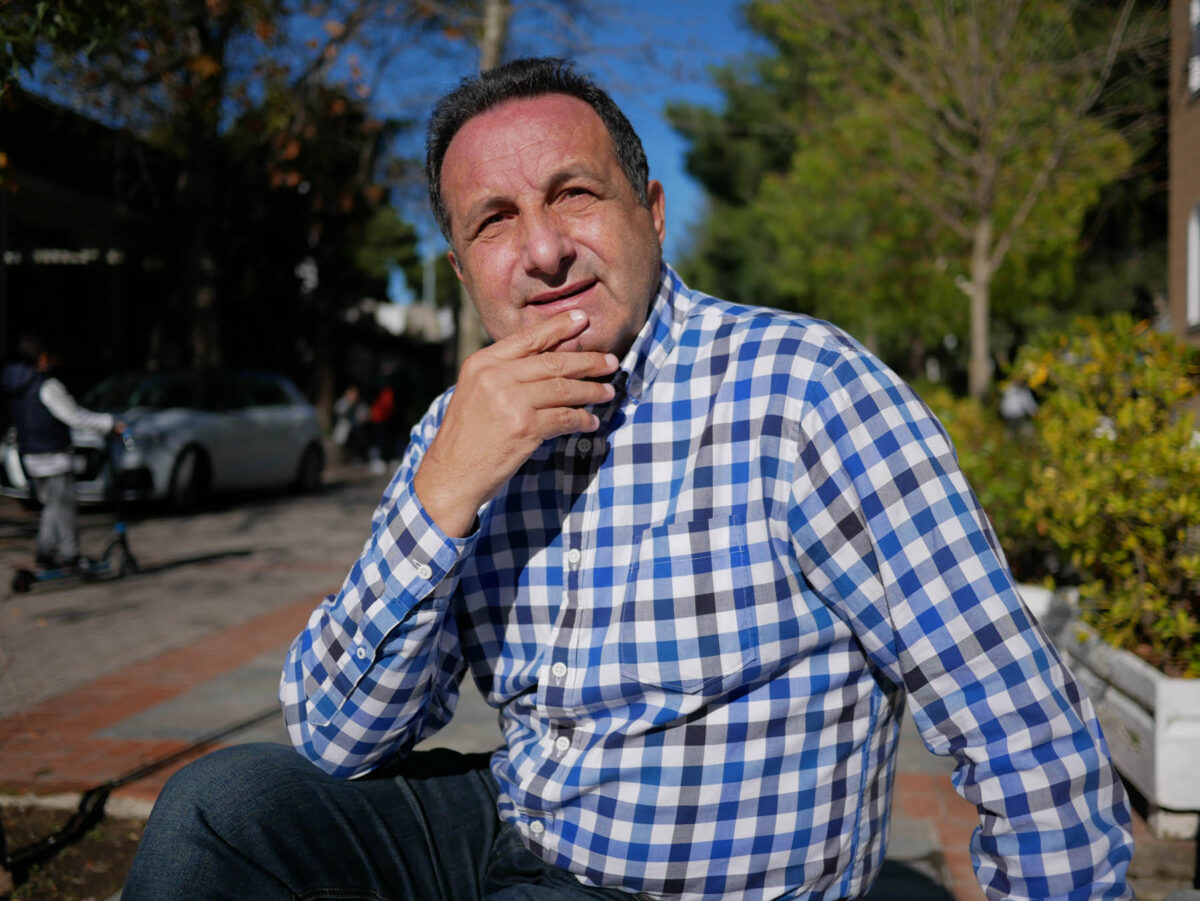citinotes
Nobles and popolo

Although situated far from the major cities of Western Europe, Greece holds a crucial geostrategic position at the crossroads between Europe and Asia. Throughout centuries, its islands have played vital roles as stops along trade routes for major maritime powers such as Venice, Genoa, and England. Similar to Syros in the Aegean, Corfu, an island in the Ionian Sea facing the Adriatic, developed a cosmopolitan character due to the centuries-old presence of foreign trade powers.
In stark contrast to the typical Cycladic white-and-blue architecture, a leisurely stroll through the streets of Corfu city serves as a reminder of the island’s proximity to Italy. The Pompeii-red and ochre-walled buildings, reaching up to five floors high, adorned with dark-green shutters, bear witness to the four-century-long Venetian rule on the island. The refined Spianada, the city’s esplanade, flanked by two beautiful arcades reminiscent of Rue de Rivoli, transports us to the era when Napoleon infused a Parisian atmosphere into Corfu. The esplanade’s cricket field is a tangible reminder of the brief period when the island served as a protectorate of the United Kingdom in the mid-19th century.
The presence of a street named after Albert Cohen in the city is not merely a testament to the Corfiots’ literary inclinations. The distinguished Jewish-Swiss novelist, known for “Belle du Seigneur,” was born in Corfu, in a neighborhood still referred to as Hebrew (“Ovraiki”) in homage to its enduring community. The island’s cosmopolitan nature extends from its streets to its kitchens; Corfiot cuisine is a vibrant melting pot, featuring recipes influenced not only by France and Russia but also by the nearby culinary traditions of Venice and Malta.
Despite the absence of feudalism in Greece, Corfu boasted its own imported nobility from Venice. Successive generations of nobles, Signori, and Signore lived in refined mansions, traversing the island in horse-drawn carriages, and indulging in operas from their private lodges at the Theater of San Giacomo. What if Napoleon’s forces had set ablaze the Libro d’Oro, Corfu’s registry of noble families — another legacy from Venice — and stripped the coats of arms from house doors? A lingering aura of nobility still permeates the Corfiot atmosphere, audible in the titles “Sior” (Sir) and “Siora” (Lady) that some individuals are still addressed with. It’s evident in the surviving slabs featuring Venice’s Lion of Saint Marc, and undeniably felt in the timeless charm of Monrepos royal mansion, the birthplace of Prince Philip, Duke of Edinburgh.
Our initial travel notes delve into the diverse rulers who shaped the island’s culture over the centuries. Authored by Joseph Reinach (1856 – 1921), a 19th-century French journalist with a profound interest in history, these impressions of Corfu were penned in 1879. Several years earlier, in 1858, Albert Mousson (1805 – 1890), a Swiss botanist, also explored Corfu. Approaching the island with the discerning eye of a scientist, Mousson conducted a thorough examination of the varied populations inhabiting Corfu, providing vivid descriptions of both their attitudes and attire.
Among the myriad writers who have discerned the impact of Italy on the Corfiot spirit was the highly acclaimed French novelist and playwright Michel Déon (1919 – 2016). Boasting an extensive bibliography comprising over 40 publications, Déon earned the prestigious accolade of membership in the Académie Française in 1978. Having devoted years to residing in and chronicling the nuances of Greece, Italy, Portugal, and other countries, Déon evolved into a seasoned authority on Mediterranean customs and cultures.
Moving forward, we encounter two additional connoisseurs of the Corfiot state of mind: Pavlos Paleologos (1895 – 1984) and Gerasimos Chitiris (1913 – 1997). Hailing from a suburb of Constantinople (modern-day Istanbul), Paleologos was a Greek writer and columnist. In one of his evocative portrayals, he encapsulates Corfu’s 19th century as a leisurely Sunday stroll along the Spianiada, the island’s grand esplanade. Crafted from marble stone, Spianada served as the ideal backdrop for the nobility to showcase their elaborate attire, towering hats, and delicate lace parasols. Those Sunday promenades marked the pinnacle of their influence, a period later recalled with profound nostalgia as their prominence gradually waned at the turn of the 20th century.
Gerasimos Chitiris emerged as one of the preeminent researchers of Corfiot history in Greece. His contributions included a dictionary of the Italian-influenced Corfiot dialect, a comprehensive volume chronicling local customs and traditions, and an exploration of the history of the Republic of the Ionian Islands. Chitiris also delved into the world of opera, documenting performances at the city’s Theater of San Giacomo. During the period spanning the early 1970s to the 1980s, his weekly column became a cherished platform, resurrecting moments from the daily lives of Corfiots. In the following excerpt, we accompany Sior Giorgis on a nostalgic journey, reminiscing about his bygone days of opulence as a noble.

Young female statues, “Kores”, adorning the Achilleion Palace in Corfu, Greece.
Citinotes
chapter 1
Melting pot
Each ruler, another culture.
This land has witnessed the reign of numerous nations throughout history: from Corinth and Macedonia to Syracuse, Rome, Byzantium, Epirus, Sicily, the Turks, Venice, France following Campo-Formio, Russia post-Amiens, and again France after Tilsitt, succeeded by England after Waterloo, and now, Greece.
The esplanade stands as a testament to the French, a creation of General Donzelot. The English, in their turn, erected a Greek temple in honor of Sir Thomas Maitland and an obelisk dedicated to Sir Howard Douglas. Little remains from the era of the Turks. Here and there, glimpses of the old lion of Saint-Marc persist, still attempting to stretch its wings, or the weathered remnants of the Revolutionary motto, reminiscent of Corfu’s transitional phase, half-erased by the rains.
Joseph Reinach, Voyage en Orient, Charpentier, 1879.
The tribes
Albert Mousson, Korfu und Cefalonien, Druck und Verlag von Fr. Schulthess, 1859.
Half-way between Italy and Greece
Brindisi stands as a Greek city, and Corfu, an Italian island. When journeying from one to the other, one can’t help but ponder whether geographers might have made some inadvertent mistake…
Michel Déon, Le rendez-vous de Patmos, La Table Ronde, 1971.

Stone plaque of the Lion of Saint Marc, emblem of the Venetian maritime republic. The plaque is a remnant ornating the Royal Gate of the New Fortress built by the Venetians in the 16th century and completed by French and British colonial rulers.

Sir Frederick Adam, Lord High Commissioner of the Ionian Islands between 1824 and 1832. His statue, crafted by Corfiot artist Pavlos Prosalentis, ornates the Palace of St. Michael and St. George which served as residence for the British High Commissionners.

A 17th-century Greek church of a style clearly influenced by the Italian Baroque.

A stroll along the Promenade of Garitsa, overviewing the Old Fortress from afar, in a photograph taken in 1900.
chapter 2
The Sunday walk of a noble
The distance between the nobility and the popolo—the common people—was marked by chaos. […] Nobles earned their titles through services to the Venetian state, and the Libro d’Oro served as the official registry of these aristocrats. Engravings of their names adorned the plaque on the esplanade (known as the Spianada). The coats of arms on their house doors were testament to the aristocratic status of the occupants.
The crowd remained distant, with the bourgeoisie maintaining a certain separation. Even public walks had designated areas of distinction. The plebs, or popolari, strolled in the middle of the Spianada, while aristocrats favored the Volta—a picturesque line of arches beneath the building complex that framed one side of the Spianada.
This was the creation of the French during their rule of the island: a replica of Rue de Rivoli in Paris, adorned with arches and large lanterns suspended from each arch.
The Volta served as a witness to the passage of all nobles: adorned in cardigans, stiff collars, and Mirabeau hats. Men would solemnly raise their hats every now and then to exchange greetings or pay homage to the Countess. She, in turn, would stroll, gracefully holding the tail of her skirt with one hand and the golden handle of her walking stick with the other.
[…] Oh, how I yearn for a Sunday morning stroll, even in the heart of the Spianada, to relish the spectacle of the nobility—moving with elegance, exchanging bows, engaging in flirtations, and gallantly kissing the fingertips of the ladies…
[…] The distinctions have long vanished. The flames of the (French) Revolution consumed the Libro d’Oro, wiped the nobles’ names from the esplanade’s plaque, and stripped the mansions of their heraldries. […]
But why do they need all that today, stripped of the wealth of their ancestors? In the past, no noble would commence a meal unless his servant heralded the occasion with a cannon firing in the mansion yard. Dinner and cannons.
If I am not mistaken, his descendant now serves as a secretary at the tax office… His meager means no longer permit the luxury of a cannonball announcing his modest meals. […] Today, the Countess might pardon your poverty. If your financial situation is not flourishing, she might even consent to offering her daughter to you… a sine nobilitas, a man “without title,” a descendant of an ox trader from a mountain village. […] Nowadays, the class distinctions persist only in the subconscious of common people who, out of respect for tradition and lineage, still reserve a special place for their lordships.
Pavlos Paleologos, Corfu, my love, Saliveros, 1958.
Παύλος Παλαιολόγος, Αγάπη μου Κέρκυρα, Σαλίβερος, 1958.




chapter 3
Once a noble, always a noble
Every morning, Sior Georgis descended from the Vianelou alley to the Cofineta and entered the alley of the Saint (note: referring to Saint Spyridon, the island’s patron saint) to pay homage. In those days, the alley resembled a communal courtyard: behind every door resided a worker or a craftsman, all connected to the city and everyday life through bonds of friendship.
Sior Georgis would invariably pause in front of each door, extending a cheerful good morning to everyone. […] Every day, the shoemaker would extend an invitation: “Sior Georgis, on your way back, treat yourself to a cup of coffee and drop by…” […] “With pleasure,” responded Sior Giorgis.
Indeed, he gladly accepted the invitation, as it provided him with an opportunity to escape his dim basement apartment, a former coal warehouse. “I put nothing in my mouth before I pay homage.” His religious reverence was as genuine and substantial as his privation. Tall and gaunt, he moved about in a greasy suit that clearly wasn’t his size. A stiff collar adorned a weary shirt, and a tie nearly as aged as his hat. Yet, everyone referred to him as “Sior” with an unwavering belief in his noble ancestry.
His return (from the church) signaled the commencement of the “show”. They all gathered in a good spirits to playfully taunt Sior Giorgis.
– “I don’t understand.” remarked the carpenter. “Why is he called Sior Georgis, while I am simply called Georgis?”
– But Sior Georgis descends from Counts!
– So much for his barony!
– “The rings may have fallen, but the fingers remain” said Sior Georgis calmly, in his thin voice.
– Didn’t you know that Sior Georgis was a Count? His father even had a horse-drawn carriage of his own and a stable at Saint Caterini. […]
– “And with our own box seats at the theater! Every second evening, we went to the opera!” added Sior Georgis with nostalgia. “And what an opera that was!…what fantastic Lucias, Figaros, Rusticanas, Rigolettos!”
– […] Not just a Count, but a Count with heraldry.
– […] And what if he had that…how did you call it? Herady?
– “A heraldry…” Sior Georgis patiently explained, “…of a wild goat whose horns held the globe.”
– […] The whole world standing over horns? Oh, that’s why there are so many of them!” The yard burst into laughter.
(Note: in Greek slang, people who have been cheated on by their partners can be ironically described as “horned”).
Every day, the carpenter concocted a new joke to tease Sior Georgis. But Sior Georgis was like a lamb: a Corfiot sparrow content to live for today and leave tomorrow in God’s hands. […] He would smoke the cigarettes offered to him, recline with his legs crossed, and start singing arias…“la donna è mobile…!”, keeping rhythm with his hand. In the recollection of a youth long gone, he was the happiest man in all Corfu.
Gerasimos Chitiris, Notes of a Corfiot, Gavriilidis, 2010.
Γεράσιμος Χυτήρης, Σημειώσεις ενός Κερκυραίου, Γαβριηλίδης, 2010.




Corfu for nobles
The most elegant spots to discover Corfu's noble glory

